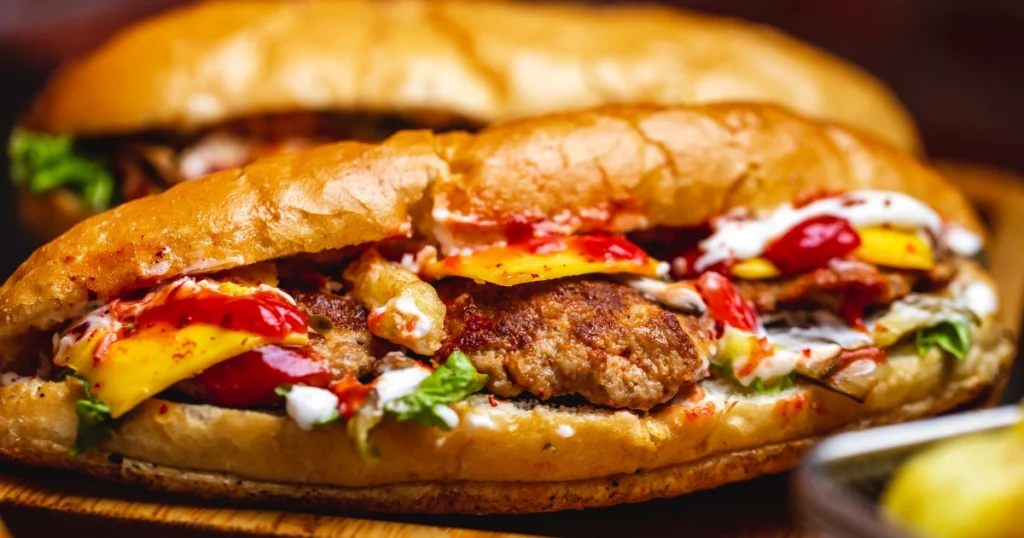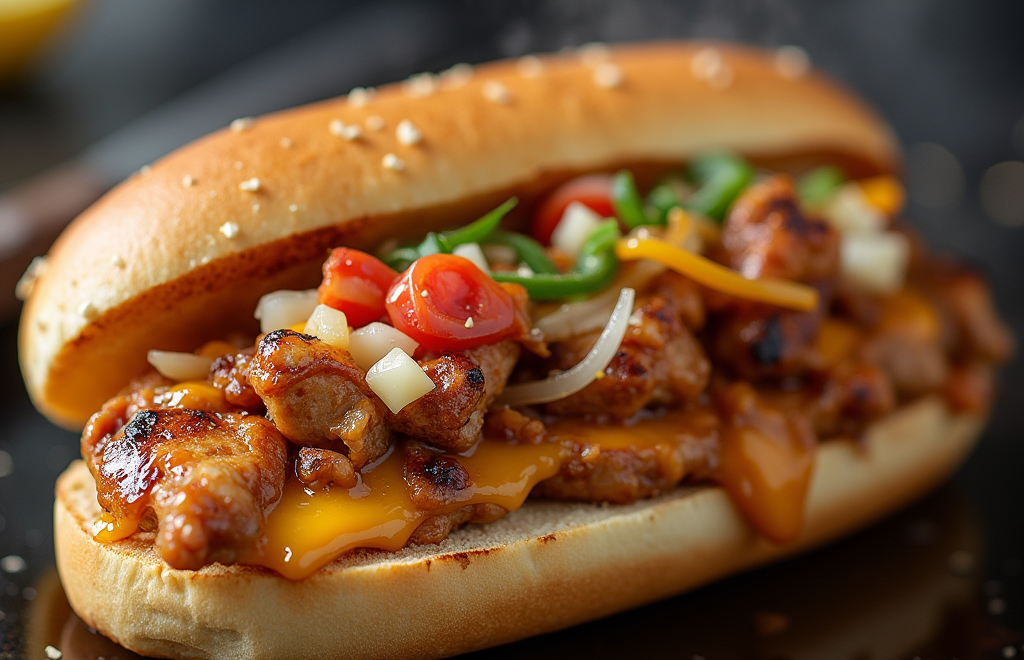
Picture this: It’s a rainy Saturday afternoon, and you’re craving something warm, cheesy, and utterly satisfying. Your stomach rumbles as you think about that perfect bite of tender chicken, melted cheese, and sautéed peppers nestled in a soft hoagie roll. But here’s the thing – you don’t need to travel to Philadelphia or break the bank at a restaurant to experience this culinary magic.
As someone who once stood in their kitchen, intimidated by the thought of recreating that iconic street food flavor, I understand your hesitation. Maybe you’re worried about soggy bread, tough chicken, or cheese that refuses to melt properly. You’ve probably wondered if you’d ever nail that perfect chicken Philly cheesesteak that tastes like it came straight from South Street.
The truth is, mastering the chicken Philly cheesesteak isn’t about secret ingredients or professional equipment – it’s about understanding a few key techniques that I’m about to share with you. Today, you’ll discover not just one, but several foolproof recipes that will transform your kitchen into your favorite cheesesteak joint.
Table of Contents
Why Choose Chicken Philly Cheesesteak Over Traditional Beef?
Health Benefits of Chicken Philly Cheesesteak for Home Cooks
When you opt for chicken over beef in your Philly cheesesteak, you’re making a decision that benefits both your wallet and your waistline. Chicken contains significantly less saturated fat compared to traditional beef, while offering a higher protein-to-calorie ratio that keeps you satisfied longer.
Your family budget will thank you too. Chicken remains one of the most affordable protein options available, making it perfect for feeding a crowd without breaking the bank. Additionally, chicken cooks more evenly than beef, which means fewer chances of overcooking – a blessing for novice home cooks who worry about ruining expensive ingredients.
Flavor Profile and Versatility
Here’s where chicken truly shines in your Philly cheesesteak journey. Unlike beef, chicken readily absorbs marinades and seasonings, allowing you to customize flavors to your heart’s content. The lighter texture appeals to a broader audience, including family members who might find traditional beef cheesesteaks too heavy.
You’ll discover that chicken works beautifully with various cheese combinations, from classic provolone to sharp white cheddar. This versatility means you can experiment with different flavor profiles without fear of overwhelming the dish.
Essential Ingredients for Perfect Chicken Philly Cheesesteak Recipes
Choosing the Right Chicken Cut
Your success starts with selecting the proper chicken cut. For beginners, boneless, skinless chicken thighs offer the most forgiving cooking experience. These cuts remain juicy even if slightly overcooked and provide richer flavor than breast meat.
If you prefer leaner options, chicken breast works wonderfully when sliced thin and cooked quickly. For ultimate convenience, pre-sliced chicken strips eliminate prep work entirely, though you’ll pay a premium for this time-saver.
Cheese Selection Guide
| Cheese Type | Melting Quality | Flavor Profile | Beginner-Friendly Rating |
|---|---|---|---|
| Provolone | Excellent | Mild, creamy | ⭐⭐⭐⭐⭐ |
| American | Superior | Classic, mild | ⭐⭐⭐⭐⭐ |
| Cheez Whiz | Perfect | Bold, tangy | ⭐⭐⭐⭐ |
| White Cheddar | Good | Sharp, rich | ⭐⭐⭐ |
Your cheese choice dramatically impacts the final result. Provolone delivers that authentic Philadelphia experience with its creamy texture and mild flavor. American cheese melts like a dream, making it perfect for beginners who want guaranteed success. For those seeking adventure, sharp white cheddar adds complexity, though it requires more careful melting.
Vegetable Components
Bell peppers form the backbone of your vegetable medley. Mix colors for visual appeal – green peppers offer slight bitterness, while red and yellow varieties contribute sweetness. Yellow or white onions provide the essential savory base, though sweet Vidalia onions work beautifully if you prefer milder flavors.
Mushrooms, while optional, add an earthy depth that complements chicken perfectly. Baby bella or cremini mushrooms hold their shape better than button mushrooms during cooking.
Step-by-Step Chicken Philly Cheesesteak Recipes for Beginners
Recipe #1 – Classic Beginner-Friendly Chicken Philly Cheesesteak
Ingredients
| Ingredient | Quantity | Notes |
|---|---|---|
| Boneless chicken thighs | 1 lb | Cut into thin strips |
| Provolone cheese | 6-8 slices | Or cheese of choice |
| Bell peppers | 2 medium | Mix of colors preferred |
| Yellow onion | 1 large | Thinly sliced |
| Hoagie rolls | 4 rolls | Fresh, not day-old |
| Olive oil | 2 tbsp | For cooking |
| Salt | 1 tsp | To taste |
| Black pepper | 1/2 tsp | Freshly ground |
| Garlic powder | 1 tsp | Optional |
Preparation Steps
Prep Work (10 minutes)
Start by slicing your chicken into thin strips, cutting against the grain for maximum tenderness. Slice vegetables uniformly – this ensures even cooking and professional presentation. Warm your rolls in a 200°F oven wrapped in foil to prevent drying.
Cooking Process (15 minutes)
Heat your skillet over medium-high heat and add oil. Sauté vegetables first, cooking until onions become translucent and peppers soften slightly – about 5-7 minutes. Remove vegetables and set aside.
Add chicken strips to the same pan, cooking until they reach 165°F internal temperature. This typically takes 6-8 minutes, depending on thickness. Return vegetables to the pan, combine everything, then reduce heat to low and add cheese slices on top.
Cover the pan briefly to help cheese melt evenly. Once melted, use a spatula to gently fold cheese into the mixture.
Assembly Techniques
Split your warmed rolls lengthwise, being careful not to cut completely through. Fill generously with the chicken mixture, allowing some overflow for that authentic overstuffed appearance.
Recipe #2 – Quick 20-Minute Chicken Philly Cheesesteak

For busy weeknights when time is precious, this streamlined version delivers maximum flavor with minimal effort.
Speed-Cooking Techniques
| Ingredient | Quantity | Prep Time Saver |
|---|---|---|
| Pre-cooked chicken strips | 1 lb | Rotisserie chicken works |
| American cheese slices | 8 slices | Melts fastest |
| Frozen pepper mix | 2 cups | No chopping needed |
| Pre-sliced onions | 1 cup | Time-saving option |
| Sub rolls | 4 rolls | Any soft roll works |
Using pre-cooked ingredients safely requires proper reheating. If using rotisserie chicken, shred into bite-sized pieces and reheat thoroughly. Frozen pepper mixes eliminate chopping while maintaining excellent flavor and texture.
High-heat cooking methods work best here. Keep your pan hot and move ingredients quickly to prevent overcooking. The assembly line approach – preparing all components before cooking begins – ensures smooth execution.
Mastering Cooking Techniques for Chicken Philly Cheesesteak
Perfect Chicken Cooking Methods
Temperature control makes the difference between succulent chicken and dried-out disappointment. Medium-high heat sears the exterior while keeping the interior juicy. Use just enough oil to coat the pan – too much creates greasy results.
Timing becomes crucial for juicy results. Thin chicken strips cook quickly, usually requiring only 2-3 minutes per side. Avoid moving pieces constantly; let them develop proper color before flipping.
Seasoning Strategies
Season your chicken strips 15-20 minutes before cooking, allowing salt to penetrate the meat. This technique, called dry brining, enhances flavor while improving texture. For enhanced flavor, consider brief marinades using Italian dressing or simple herb combinations.
Remember that salt timing affects moisture retention. Early salting draws out moisture initially but then allows the meat to reabsorb it along with dissolved salt, creating better seasoning throughout.
Vegetable Preparation Secrets
Achieving perfect vegetable texture requires understanding the difference between caramelization and simple sautéing. Caramelization develops deeper flavors but takes longer. For busy weeknights, quick sautéing maintains crunch while softening harsh raw flavors.
Prevent mushy vegetables by avoiding overcrowding your pan. Cook in batches if necessary, allowing each piece adequate contact with the hot surface. Color retention improves when vegetables maintain slight firmness.
Cheese Melting Mastery
Low and slow melting prevents separation and creates that coveted smooth, creamy texture. Once you add cheese, reduce heat immediately and cover the pan. Steam helps distribute heat evenly, preventing hot spots that cause clumping.
If cheese begins separating, add a splash of milk or cream and stir gently. This technique rescues overheated cheese and restores smooth consistency.
Troubleshooting Common Chicken Philly Cheesesteak Problems
Solving Texture Issues
Dry chicken often results from overcooking or using lean cuts without proper technique. Combat this by choosing thighs over breasts, cooking to exact temperature (165°F), and letting meat rest briefly before serving.
Soggy bread frustrates even experienced cooks. Prevent this by toasting rolls lightly, draining excess liquid from vegetables, and serving immediately after assembly. Consider scooping out some bread from the roll’s interior to create more room for filling.
Flavor Enhancement Tips
Balance salt and fat for optimal taste. Chicken Philly cheesesteak should taste rich but not heavy. Add depth with seasonings like smoked paprika, onion powder, or a dash of Worcestershire sauce.
Umami boosters transform good chicken into great chicken. Try adding a small amount of soy sauce, mushroom powder, or even a touch of anchovy paste for complexity without identifiable fishy flavor.
Serving Suggestions and Storage Tips
Traditional Accompaniments
Classic sides include crispy French fries, tangy pickle spears, and cold beverages. Consider different fry cuts – shoestring for crunch, steak fries for heartiness, or sweet potato fries for nutritional variety.
Storage and Reheating
Proper storage extends your enjoyment of leftover chicken Philly cheesesteak. Refrigerate components separately when possible – bread, chicken mixture, and fresh vegetables maintain better quality this way.
For reheating, the oven method produces the best results. Wrap assembled sandwiches in foil and warm at 350°F for 10-12 minutes. Skillet reheating works for the filling alone, while microwaving should be your last resort due to texture changes.
Conclusion
Creating the perfect chicken Philly cheesesteak at home isn’t just about following a recipe – it’s about understanding the techniques that make each component shine. From selecting the right cut of chicken to mastering the art of melting cheese without clumping, these beginner-friendly recipes provide the foundation for countless delicious meals.
Remember, the best chicken Philly cheesesteak is the one that brings joy to your table. Whether you choose the classic approach with provolone and peppers, opt for the quick 20-minute version for busy weeknights, or create your own signature variation, the key is starting with quality ingredients and cooking with confidence.
Don’t wait for the perfect moment or worry about achieving restaurant-quality results on your first attempt. Grab your ingredients, heat up that skillet, and start your chicken Philly cheesesteak adventure today. Your family will thank you, your taste buds will celebrate, and you’ll wonder why you waited so long to master this incredible comfort food classic.
Ready to get started? Choose your favorite recipe from above, gather your ingredients, and let’s make some magic happen in your kitchen right now!
FAQ About Chicken Philly Cheesesteak
What’s the best way to slice chicken for Philly cheesesteak? Slice chicken against the grain in 1/4-inch thick strips. Partially freezing the chicken for 15-20 minutes makes slicing easier and more uniform.
Can I make chicken Philly cheesesteak ahead of time? While best served immediately, you can prep components 24 hours ahead. Store chicken, vegetables, and cheese separately, then assemble and heat when ready to serve.
What temperature should chicken reach for a safe Philly cheesesteak? Always cook chicken to an internal temperature of 165°F (74°C) for food safety. Use a meat thermometer to ensure accuracy.
How do I prevent my chicken Philly cheesesteak from getting soggy? Toast the rolls lightly, drain excess liquid from vegetables, and avoid over-saucing. Serve immediately after assembly.





